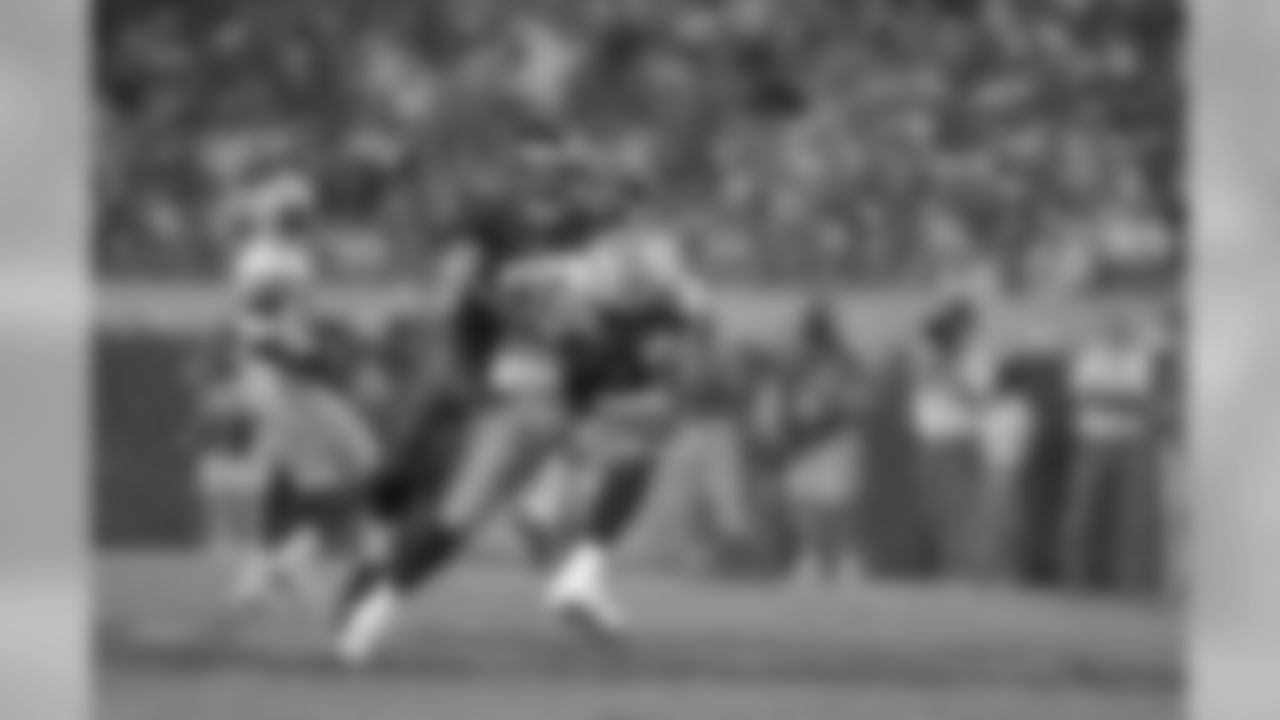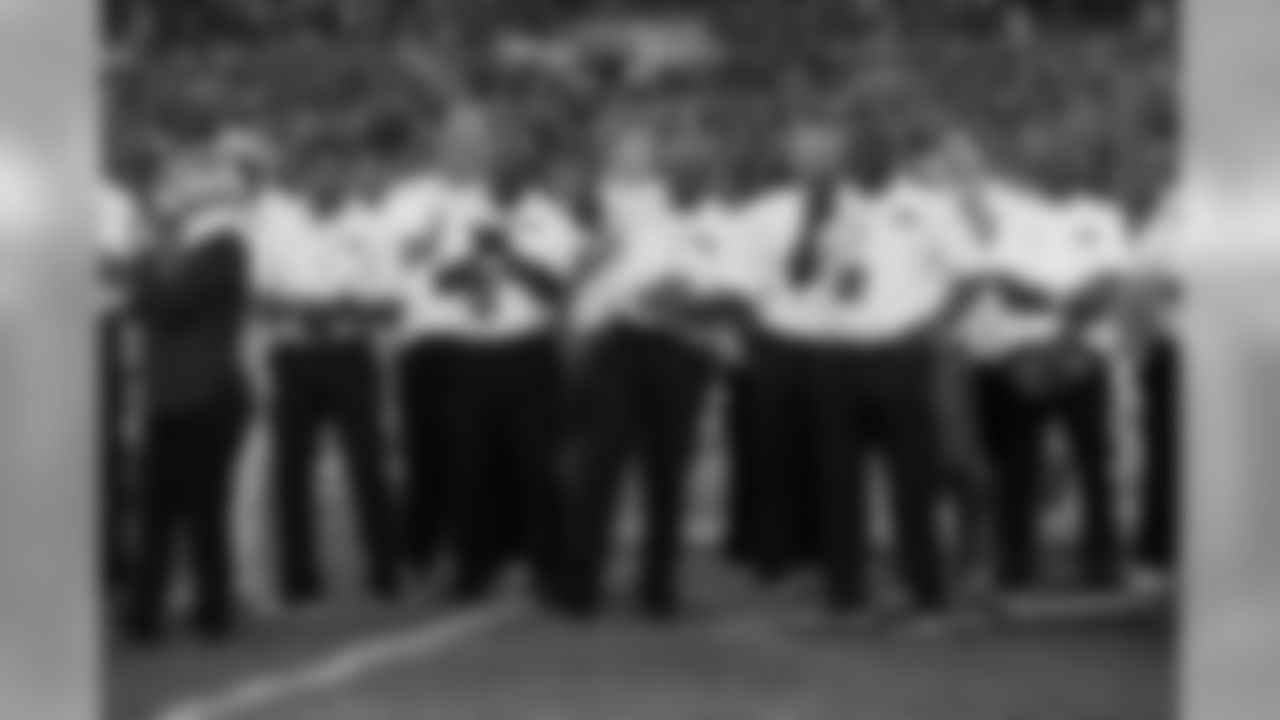On the first day of February in 2014, 17 former NFL greats waited to hear if their names would be called for induction into the Pro Football Hall of Fame. For the first time, John Lynch was among that group, the best of the best, the cream skimmed from more than 100 initial nominees.
Four years later, Lynch is in that group again, a finalist for the Hall of Fame's Class of 2018. The group around him, however has changed. In 2014, Lynch shared the ballot with teammate Derrick Brooks along with 15 others, including Walter Jones, Andre Reed and Aeneas Williams. This year, Hall voters are parsing such names as Ray Lewis, Randy Moss and Terrell Owens.
Lynch is the only one of those 17 finalists in 2014 who is now on the 2018 ballot, and the reason for that is simple: All the others have since been voted in.
It's time for Lynch to rejoin his original group of finalists and don a gold jacket. A five-year waiting period is certainly nothing unusual – Kevin Greene and Jerome Bettis recently got in as fifth-time finalists; Tim Brown, Cris Carter and Charles Haley waited six years; Andre Reed needed eight. With a maximum of five modern-era inductees each year, crowded ballots can lead to deserving players being edged out. That has been the case for Lynch, but his wait should come to an end with selection to the Class of 2018.
(For a more in-depth analysis of Lynch's Hall of Fame credentials, click here.)
John Lynch was an impact player in every sense of the word. In the most literal sense, it defines his reputation as a legendarily fierce tackler. Lynch has long been considered one of the hardest hitters in NFL history, and he was named to the top 10 "most feared tacklers," in an NFL Films special, joining the likes of Dick Butkus, Ray Lewis and Ronnie Lott. When a John Lynch discussion begins, before anyone gets around to the excellent numbers (such as 1,054 tackles and 26 interceptions) and overwhelming list of accolades (such as nine Pro Bowl selections), it is his hitting that comes first.
"I never had a guy hit me as much as John hit me in one game," said Hall of Fame running back Marshall Faulk, who absorbed one of Lynch's most memorable hits during a 2000 Monday Night Football game. "He caught me and must have flipped me over and the only thing I could do was just tell him to keep bringing it, knowing that he was bringing it about as hard as I wanted him to."
Check out photos of Hall of Fame Semifinalist and former Tampa Bay Buccaneer S John Lynch.




















When the Hall of Fame opened its doors to former Buccaneers defensive tackle Warren Sapp in 2013, it did so despite a career sack total that fell a bit shy of 100. Sapp, a first-ballot selection, was an easy choice for Hall voters because he redefined how the defensive tackle position was played and had an enormous impact on the NFL. Similarly, Lynch stands out from his contemporaries at his position because, in addition to making plays deep in the secondary he was also an incredible force closer to the line of scrimmage. That sort of safety is now highly coveted in the NFL.
The Buccaneers' defense of the mid-90s through the early years of the new millennium was so good that it has entered the NFL lexicon. What was once known as the "Cover Two" defense is now widely referred to as the "Tampa Two." Lynch thrived in that defense with a combination of instincts, coverage skills, fierce and will. His play was as important to the Buccaneers' sustained success – and eventual Super Bowl victory – as Sapp's pressure up the middle and Derrick Brooks' sideline-to-sideline range. Tony Dungy, Tampa Bay's head coach from 1996-2001 and a primary architect of that great defense, said that Lynch had the most difficult job on the field, one that required him to hold up against big backs near the line, to cover tight ends and receivers and be responsible for huge areas of the field in the secondary.
Dungy later coached the Indianapolis Colts to a Super Bowl title and his defense featured a high-impact safety in Bob Sanders. Sanders, notably, patterned his game off of Lynch.
"Meeting John was at the top of my list when I made the Pro Bowl after my second year," said Sanders, the 2007 NFL Defensive Player of the Year. "His longevity, respect and playmaking ability are what I strive for in this league. His play changed the dynamics of the safety position."
Sanders' point is one of the key arguments for how Lynch's value as a player transcended his (still excellent) raw statistics. As former Buccaneers Defensive Backs Coach and current Pittsburgh Steelers Head Coach Mike Tomlin noted, much of what Lynch did to make the Buccaneers' legendary defense work didn't show up in the stats page.
"Numbers don't tell the full story of John's impact,'' Tomlin. "He absolutely destroyed the tight end-side run game of everyone we played. He also blew up the 'B' gap, and he did it in an unselfish manner.''
Lynch does have the numbers, too. His nine Pro Bowl selections – five with the Buccaneers and four more with the Denver Broncos – put him in an elite group, most of which is already in the Hall. The only safety who went to more Pro Bowls than Lynch is Ken Houston, a Hall of Famer who made 10 all-star games.
The Associated Press All-Pro team is an even more exclusive honor than the Pro Bowl, and Lynch made that squad four times, twice as a first-team choice. Those selections all came during a four-year run (1999-2002) that coincided with the best work put together by that Buccaneer defense. Collectively, those consecutive honors are the sign of a player who is considered one of the best, if not the best, at his position for a sustained period. The NFL Alumni also named Lynch the defensive back of the year in 2000.
Lynch was a consistently elite defender once he became a full-time starter in 1996. He reeled off nine different seasons with at least 90 tackles, and only three defensive backs had more stops during the 15 seasons Lynch was active – Lawyer Milloy, Rodney Harrison and Robert Griffith. In pass protection, Lynch added 26 interceptions and 100 passes defensed, with at least one pick in 11 straight campaigns (1995-2005). He also had 13 sacks and 16 forced fumbles in his illustrious career.
Photos from Buccaneer legend John Lynch's Ring of Honor halftime ceremony.

John Lynch

John Lynch's honorary sign being unveiled

Gene Deckerhoff and John Lynch

Gene Deckerhoff

Fireworks from John Lynch's Ring of Honor Ceremony

John Lynch

John Lynch

John Lynch

John Lynch

John Lynch's family

Avie Glazer, Joel Glazer, Darcie Glazer Kassewitz, and Bryan Glazer look on as John Lynch addresses the crowd.

Former Buccaneers players

Avie Glazer, Joel Glazer, Darcie Glazer Kassewitz, and Bryan Glazer

John Lynch

John Lynch

John Lynch

Avie Glazer, Joel Glazer, John Lynch, Darcie Glazer Kassewitz, and Bryan Glazer

John Lynch and fellow Ring of Honor Members

John Lynch and his family
"John Lynch is one of the best football players I've ever played against," said Indianapolis/Denver quarterback Peyton Manning, himself a sure-fire first-ballot Hall-of-Famer. "In my opinion, he's one of the top safeties to ever play the game. His ability to deliver game changing hits caused you as a player to always know where he was on the field. He was an unbelievable competitor, great leader and a class act."
Lynch gained a reputation as a clutch player in close games, leading Defensive Coordinator Monte Kiffin to nickname him "The Closer." As an example, that same Monday night game in which he sent Faulk sprawling ended with his interception in the final minute, sealing the Bucs' wild, 38-35 victory.
"When you say a player is great, the obvious criteria is his play and talent, but there's another ingredient that I think is equally important and that's the intangible… the 'it factor' as some describe it," said Jerry Angelo, the Buccaneers' director of player personnel when Lynch was drafted in 1993. "It's what he meant to his teammates, his coaches and his fans and when you factor that into the equation, then the only place that can recognize John for what he did and who he was, is Canton, for he truly was a Hall of Famer."
Led by that amazing defense, the Buccaneers climbed to the NFL's peak for the first time in 2002, advancing to and winning Super Bowl XXXVII. Tampa Bay might still be searching for its first Lombardi Trophy if not for the presence of Hall of Famers Derrick Brooks and Warren Sapp, and the same can be said about Lynch. Not only is Lynch a champion – another important factor for Hall of Fame voters – but he was one of the main reasons his teammates can say the same.
"John Lynch is one of the core players who turned this team around and made it great, and I mean that in regards to both his play on the field and the way he conducted himself off the field," said Buccaneers Co-President Joel Glazer. "He was always one of those players you couldn't help rooting for, because he worked so hard at the game, obviously cared very deeply about the team's success and was a true professional in every sense of the word."
Glazer and the Buccaneers fully understand what Lynch brought to the team and to the NFL; they inducted him into the Ring of Honor at Raymond James Stadium in 2016. Notably, the Denver Broncos did the same that year despite Lynch only playing four seasons for their franchise. It has long been clear to those around him that Lynch was the complete package: a champion, a game-changer, a Pro Bowler, a leader and most of all a player who always made a memorable impact. Together, that describes a Pro Football Hall of Famer. Canton should end the wait on Saturday night and make the call to John Lynch.





















